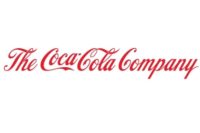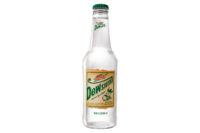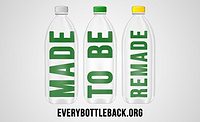Starting in 1994, Disney character Fud Wrapper from the EPCOT attraction Food Rocks taught consumers about nutrition by reminding them to “always eat with moderation,” when choosing healthy foods versus sweet snacks. The character explained the importance of a balanced diet with grains, protein, dairy, fruits and vegetables but noted that consuming a little bit of sweets and other junk foods is acceptable in small doses. More than 10 years after the attraction’s closing in 2004, the American Beverage Association (ABA) is touting a similar message for beverages in order to encourage greater consumer health.
The Washington, D.C.-based organization joined forces with the Alliance for a Healthier Generation, which was founded by the American Heart Association and The Clinton Foundation, as well as The Coca-Cola Co., PepsiCo Inc. and Dr. Pepper Snapple Group to support the Clinton Global Initiative (CGI) Commitment, which includes a goal to reduce beverage calories consumed per person nationally by 20 percent by 2025.
“It’s very much a stretched goal,” explains ABA President and Chief Executive Officer Susan Neely. “It’s a goal that’s based on the industry’s business overall continuing to grow, and so, we, [with] the individual companies, look at what they have planned in terms of innovations and their own strategies. [Twenty percent by 2025] was just a number that we collectively decided was a true stretch goal but one that made sense.”
This initiative comes at a time when 70 percent of Americans are overweight or obese, according to Chicago-based Mintel’s November 2014 report “Diet Trends – US.” More specifically, the Centers for Disease Control and Prevention, Atlanta, reports an adult obesity rate of 34.9 percent or 78.6 million U.S. adults and a childhood obesity rate of 17 percent or 12.7 million children and adolescents aged 2 to 19, based on 2012 data cited in a 2014 report from “The Journal of the American Medical Association.”
To reach its calorie-reduction goal and curb obesity, the CGI Commitment, also known as the Balance Calories Initiative, is using a two-pronged approach that includes initiatives at the national and community levels. At the national level, the beverage companies plan to use their marketing, innovation and distribution capabilities to increase and sustain consumer interest in and access to beverage options to help them reduce their calorie consumptions. At the community level, the companies will target areas in which interest in and access to reduced-calorie products has been limited. In order to reach the calorie-reduction goal, promotions will highlight consumption of bottled waters.
“Consumers want more options to balance or reduce their calories, and those options can be smaller portion sizes [or] they can be options with lower calories,” Neely says.
Through these efforts, the ABA expects that bottled water, lower-calorie and smaller-portion beverages will grow. Although Neely could not comment on any new product developments in line with this initiative, she points to recent product releases, such as Purchase, N.Y.-based PepsiCo’s Pepsi-Cola Made with Real Sugar 7.5-ounce mini cans as an important calorie-control option that has reignited the mini can trend.
“If you look at what’s been very, very popular this last year, it’s the traditional sodas in the mini cans, and those are just flying off the grocery store shelves,” Neely explains. “That’s a way to balance your calories: You can enjoy one of the soft drinks that you’ve always enjoyed; you’re just having it in a smaller portion size.
“I think the smaller portion option is a really important part of this equation,” she continues. “We still expect people to enjoy their Coke and Dr Pepper and Pepsi and all of the soft drink brands, but they can choose them in a smaller portion, and that’s a way to enjoy it without the same amount of calories.”
Counting calories
Other healthy soft drink launches in the past year include Atlanta-based The Coca-Cola Co.’s U.S. release of Coca-Cola Life and PepsiCo’s Pepsi True, Neely notes.
Following pilot tests in Chile and Argentina in 2013, The Coca-Cola Co. brought Coca-Cola Life to select The Fresh Market stores in the United States in August 2014, followed by a national roll-out in November 2014. Coca-Cola Life is the company’s first reduced-calorie carbonated soft drink sweetened with cane sugar and stevia leaf extract. It also contains 35 percent fewer calories than leading colas, underscoring the company’s global commitment to provide an expanded selection of reduced-, low- and zero-calorie beverage options, the company says.
“People that love our brands want more choices in flavors, package sizes and sweetener options,” said Andrew McMillin, vice president of Coca-Cola brands for Coca-Cola North America, in a statement. “With Coca-Cola Life, we’re meeting those needs while serving up a delicious beverage that complements our broader portfolio. As we continue to follow our consumers, we are working ultimately to become a leader in this interesting and emerging category.”
Coca-Cola Life is available in six-packs of 8-ounce glass bottles, six-packs of 12-ounce cans, Fridge Pack 12-packs of 12-ounce cans, individual 20-ounce bottles and 2-liter bottles.
Also capitalizing on sweetener blend trends, PepsiCo announced the development of Pepsi True in early October. The new formulation contains fewer calories and 30 percent less sugar than regular Pepsi at 60 calories and 16 grams of sugar in each 7.5-ounce mini can, the company says. In addition, the soda does not contain high-fructose corn syrup and instead is sweetened with real sugar and stevia leaf extract. Twelve, 10- and 7.5-ounce packages of Pepsi True originally were available on amazon.com, and the company is planning to expand availability into other retail channels throughout the nation in early February.
In addition to healthier beverage options, the CGI Commitment will aim to educate consumers about balancing their caloric intakes. Each of the participating beverage companies has agreed to provide calorie counts and promote calorie awareness on all beverage-company-controlled point-of-sale equipment nationwide, including more than 3 million vending machines, self-serve fountain dispensers, and retail coolers in convenience stores, restaurants and other locations.
This effort, in some ways, is an extension of the ABA’s Calories Count Vending Program, which it launched in 2012. As part of this initiative, participating The Coca-Cola Co., PepsiCo and Dr Pepper Snapple Group vending machines are tagged with a vending snipe at eye level that reads, “Calories Count. Check then choose,” to remind consumers to consider the nutritional content of their beverages. The selection buttons on the machines also feature calorie labels, helping consumers choose the amount of calories that are right for them on each use occasion.
This effort also is in line with the U.S. Food and Drug Administration’s (FDA’s) recently updated vending machine calorie-label rules, which require operators who own or operate 20 or more vending machines to disclose calorie information for food sold from vending machines. The updated rule was announced in late November 2014, and operators have two years to comply with the new regulation, according to the FDA website.
In response to the new FDA regulations, the ABA stated: “America’s beverage companies are ahead of the curve when it comes to providing consumers the information they need to make the choices that are right for them. We have already put clear calorie information on the front of every bottle, can and pack we make, and we’re providing calorie information on company-controlled vending machines. FDA’s announcement provides consumers nationwide with consistent information about the foods and beverages they consume outside the home.”
The soft drink companies also have committed to education within other retail channels, such as by expanding availability of lower-calorie and smaller-sized beverages, creating end-of-aisle and checkout displays featuring only reduced-calorie beverages, providing coupons to promote interest in no- and low-calorie options, and sampling efforts.
“This is the single largest voluntary effort by an industry to help fight obesity and leverages our companies’ greatest strengths in marketing, innovation and distribution,” Neely said in a statement. “This initiative will help transform the beverage landscape in America. It takes our efforts to provide consumers with more choices, smaller portions and fewer calories to an ambitious new level.”
Targeting teens
Also as part of these efforts, the ABA, in association with The Coca-Cola Co., PepsiCo and Dr Pepper Snapple Group, has created a specific marketing campaign called Mixify to share the CGI Commitment’s message with teens and their parents. “Mixify is about finding new mixes of foods, drinks and physical activities that keep you looking and feeling good, even when life gets a little crazy,” the ABA said in a statement. “The name ‘Mixify’ is a reminder to find a balanced mix every day — in a way that’s totally unique to you.”
The multi-year national consumer awareness and engagement program uses national TV and digital advertising platforms as well as social engagement on mymixify.com and through the hashtag #mymixify. These platforms invite teens to join real-time social media feeds; ask questions of dietitians, nutritionists and athletes for healthy consumption tips; and access other resources that can help them achieve balanced diets and lifestyles, the ABA says. Mixify’s social media accounts, including Facebook, Twitter, Tumblr and Instagram, post pop culture references to engage teens as well as infographics with simple tips that encourage healthy consumption and exercise.
Healthy hydration
In line with these nutritional efforts but outside of the CGI Commitment, SodaStream International Ltd., Airport City, Israel, shifted its positioning at the end of last year to become a healthy hydration brand.
“We are changing our strategic approach, moving away from being a soda alternative to where we are now, a water company,” says Scott Guthrie, general manager of Americas at SodaStream. “This shift in focus is something we call ‘Water made exciting.’ SodaStream is providing a platform that offers a simple, fun and sustainable way to enjoy sparkling water and flavored sparkling water. You will see this transformation across everything we do, from our product offerings to our marketing, as we lead a revolution in the beverage industry toward healthy hydration.”
Prior to the announcement, SodaStream commiss-ioned a study by New York-based consulting firm Northstar about consumer attitudes toward water. The survey found that although most Americans know water is essential for good health, 40 percent still choose other beverages to quench their thirst, with 14 percent choosing carbonated soft drinks, 11 percent opting for tea, and 10 percent selecting flavored water. However, survey respondents noted that they would drink
more water if it tasted better (35 percent), had flavor (28 percent) or had bubbles (8 percent) as well as if they knew about the health benefits of drinking water
(31 percent).
The company commissioned another study through celebrity fitness trainer and Sunday Set-Up Founder Kathy Kaehler that found that participants who were given a SodaStream machine increased their water intake by 46 percent within four weeks. This equates to drinking 7.5 more 8-ounce glasses of water each week, the company says. Women, in particular, boosted their water intake by 72 percent or more than 9.5 glasses each week, it says. This is predominantly attributable to these consumers opting for sparkling water instead of carbonated soft drinks and energy drinks, it notes.
“Americans recognize that water plays a vital role in promoting a healthy lifestyle, and SodaStream is a powerful tool that enables our consumers to increase their water intake,” Guthrie says. “Drinking water helps maintain the balance of body fluids, stimulates weight loss, energizes muscles, and keeps your skin looking good. When you drink more water, you will feel good and look good. Not to mention, reducing the consumption of sugary beverages significantly reduces the risk of diet-related diseases such as obesity, diabetes, heart disease and gout.”
To continue to encourage consumers to drink more water, SodaStream plans to shift its product offerings this year to provide more unique, better-for-you “water plus” beverage products and introduce new sparkling water flavors with natural ingredients, low sugar and no artificial sweeteners, Guthrie says. “With this, we are in the process of delisting SKUs that do not fit within our new strategy, and we will introduce new flavor bottles and packaging to support the launch of a number of new on-demand beverage systems.”
Diets by demographic
As all of these initiatives recognize, consumers are increasingly looking for low-calorie and low-sugar options, but the overall health and wellness consumer packaged goods market also is on the rise as consumers strive to make healthier choices, according to Matthew Hudak, U.S. analyst at Euromonitor International, Chicago. “Many Americans are focused on guilt-free indulging and eliminating specific things from their diets,” he explains.
Hudak also notes that the economic uptick is helping to ease the price concerns associated with eating healthy, allowing more Americans to afford healthier food and beverage options. In recent years, more than half of surveyed consumers had noted rising food prices as a barrier to healthy eating, and 54 percent of consumers agreed that healthy foods were too expensive to eat regularly, according to New York-based Nielsen’s August 2014 report “Health & Wellness in America.” However, this is becoming less common, as more consumers are willing to spend extra money on healthier options, Euromonitor’s Hudak says.
Mature consumers, like baby boomers, are especially interested in investing in these healthier items in order to find an enjoyable consumption experience that also supports their health, Hudak points out. According to Nielsen’s report, baby boomers control more than 70 percent of the U.S. disposable income and are driving much of the demand for healthy products. When asked about ingredient preferences, 62 percent of surveyed baby boomers said they want more fiber, followed by antioxidants, heart-health ingredients, and vitamins and minerals at 57 percent each, vitamin D and omega-3s at 56 percent each, calcium at 54 percent, and whole grains with 53 percent, according to the report.
Interestingly, millennials also are interested in these ingredients but rank them in a different order, the Nielsen report points out. For this age group, the
Top 3 ingredients they are seeking more of are calcium, vitamins and minerals, and fiber, each noted by 38 per-cent of surveyed millennials, according to the report. However, millennials tend not to be as interested in healthy products as older consumers and prefer to spend their disposable incomes on quality experiences, sacrificing health for taste, Eurmonitor’s Hudak says.
Taste also seems to be important to consumers in general. According to Nielsen’s report, half of surveyed consumers agreed that “healthy food should taste good, and I am not willing to give up taste for health.” This indicates a market opportunity for manufacturers to create food and beverage products that balance health and taste.
Another opportunity for manufacturers lies in the development of weight management products, Nielsen reports. “Almost two-thirds of Americans state that they ‘don’t exercise enough,’ while more than half agree that they splurge on foods when dining out at restaurants and often surrender to their cravings for tasty but unhealthy food options,” it says in the report. As such, weight management ranks high for consumers in both the “managing” and “concerned about preventing” categories, it states. In fact, weight management is one of the Top 2 wellness aspirations for consumers of all age cohorts, it reports.
Read the wrapper
When looking for products that meet weight management or other health-related functional claims, consumers are increasingly checking the ingredients listings and Nutrition Facts Panels of products prior to purchase, Nielsen’s report notes. The market research firm found that 55 percent of surveyed consumers select products for purchase based on their ingredient lists, up 13 percentage points from 2006, and 54 percent select products based on the Nutrition Facts Panel, up
9 percentage points from 2006, based on 2013 data.
Those who do read the Nutrition Facts Panel are looking predominantly at calories, sugar content and sodium, Euromonitor’s Hudak says. In the ingredients listing, these consumers are checking for the presence of preservatives and unnatural additives as well as the number of overall ingredients, he notes. “Few and simple ingredients is a big focus,” he says.
Although consumers are reading labels and making decisions based on them, not all consumers fully comprehend what they are reading. Nielsen reports that six out of 10 shoppers say they “mostly” understand nutritional information on packaging, 35 percent only understand it “in part,” and 7 percent do not understand it at all. This leaves room for manufacturers and retailers to continue to streamline the nutritional information reporting process and educate consumers about the benefits of products so that they can balance their nutrition and enjoy all types of products in moderation.








